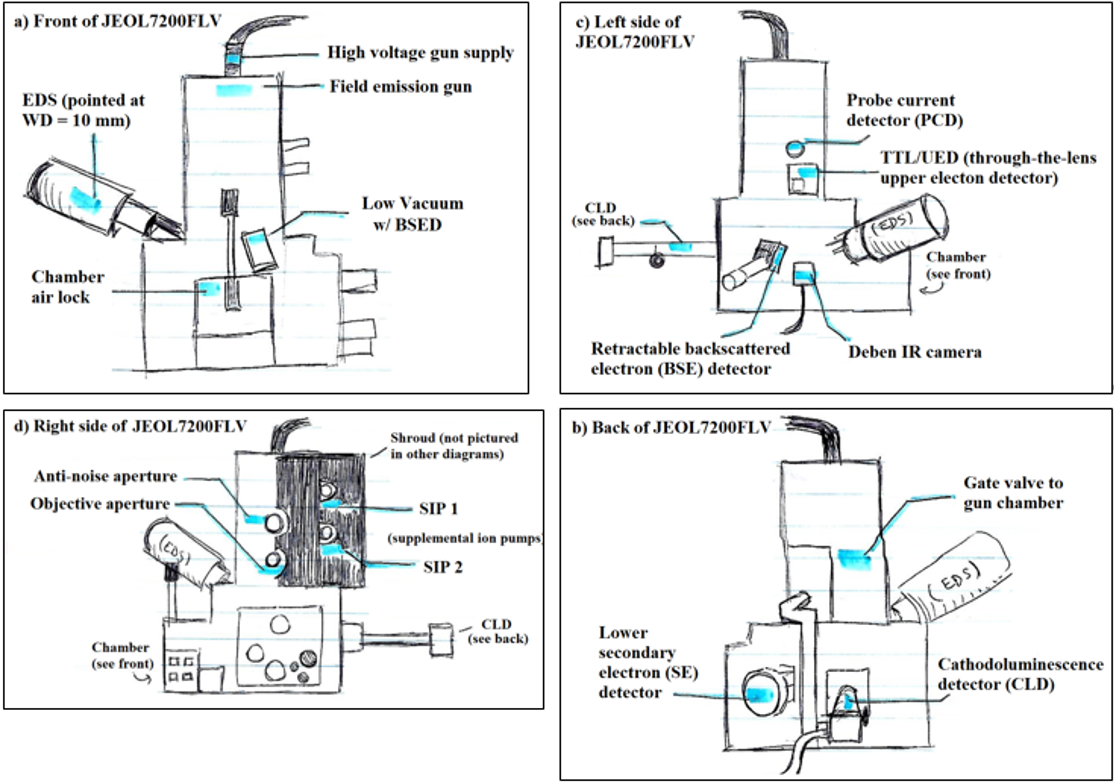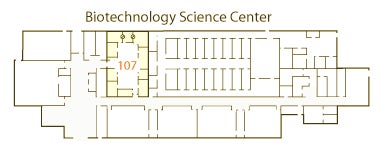
JEOL Scanning Microscope 7200 with Field emission e- gun and Low Vacuum function
The JEOL 7200flv is capable of generating signals from samples by scanning an electron probe (100V through 30,000V) across a sample thereby generating and subsequently detecting:
-electrons (secondary and backscattered)
-xrays (with Oxford Ultimax100 Energy Dispersive Xray Spectroscopy, EDS system),
-lower energy radiation (visible and IR) with the DEBEN CENTAURUS cathodoluminecence detector (CLD).
The electron gun
The JEOL 7200flv has a Schottky thermionic field emission e- gun which is a great multiuse source with the stability and probe current required for EDS analysis and the fine probe size required for high resolution imaging. The best of both worlds - FEG and thermionic!
https://www.jeol.co.jp/en/words/semterms/search_result.html?keyword=Schottky%20emission
The electron probe is quite small with fairly easy imaging at 100,000x - 1,000,000x is attainable with patience. Special supplemental ion pumps are required to maintain gun chamber pressures of 3E-8 Pa at all times, the gun never stops emitting until it fails (few years lifetime).The sample chamber (at ~1E-4 Pa) and column are well evacuated at all times because of the sample air lock.
JSM7200FLV
Related links:
DEBEN CENTAURUS cathodoluminecence detector (CLD)
Oxford Ultimax100 Energy Dispersive Xray Spectrometer
Oxford GSR resources
The JSM7200FLV data sheet from JEOL
Guide to SEM from JEOL
UNDER CONSTRUCTION BELOW HERE.....
TCS (true confocal scanner) SP5 (spectral imaging with up to 5 detectors)
-MP laser tunable from 680nm-1080nm - >3 Watts power at peak output
-MP laser 80MHz, femtosecond pulses make 2PA events likely enough to produce fluorescent micrographs
-also with 405nm and 561nm diode lasers and Argon and HeNe gas lasers with multiple lines selectable (458,476,488,496,514,and633nm)
-with 6 non-descanned detectors, 4 descanned detectors and with TLD (Transmitted Light Detector, PMT) and standard epifluorescence
-with prism/slit based, full spectrum tunable emission filtering
-with AOTF filtering allowing ROI (region of interest) specific illumination
Leica SP5 in descanned mode,
the emitted/reflected light passing through the detector pinhole is diffracted by a prism and distributed to four detectors each with a slit allowing mapping of different wavelengths with 1nm spectral resolution. This varying light intensity is transformed into electrical signals by photomultiplier tubes and displayed on the computer monitor screen.
In non-descanned mode (usually MP detection), the detectors are very close to the sample making detection efficiency high. Each non-descanned detector is matched with an emission filter allowing simple spectroscopy with the NDDs as well as the high spectral resolution of the DDs. The NDDs' emission filters cover the visible spectrum. When using NDDs don't forget to turn off the room lights.
There are a number of benefits associated with the use of the JSM7200FLV SEM:
• Light rays from outside of the focal plane dination of imaging with physiological measurements.
•With the Leica SP5 microscope (in non-MP mode) and optimal pinhole, resolution is as low as 200nm in XY and 350nm in z axis.
Further benefits come with JSM7200FLV scanning electron microscopy:
•In MP mode the z-resolution is further improved (making pinhole unnecessary) due to the superlinear absorption qualities of 2 photon abso
•In MP mode, penetration depth is increased relative to standard confocal imaging.
JSM7200FLV Related links:
• Leica literature relating to the SP5 TCS MP
• objective lenses available for Leica SP5 at MBIC
• information allowing processing of .lif images with NIH imageJ ; from this page, save the loci_tools.jar to your ImageJ plugins folder
Other general confocal links:
The confocal microscope permits examination of living cells without leading to their demise. Using laser light source, confocal microscopy produces sharp fluorescent images because light from only one focal plane is used to produce the image. Light from other "out of focus" planes is blocked by a detector pinhole, part of the optical system of the microscope (see an animation of how the confocal microscope works http://www.olympusconfocal.com/java/confocalsimulator/index.html, an interactive simulation made by Olympus of a similar confocal microscope.
• http://rsb.info.nih.gov/ij/ NIH Imagej free download for image analysis.
•http://www.nephrology.iupui.edu/imaging/software/confocal-assistant.exe Confocal Assistant free download for simple image analysis.
These tools and others are utilized to aid in characterizing and understanding nanomachines, molecular systems and cell biology through research. To discuss use of the system and/or other imaging systems of interest, please contact Dr. Michael L. Norton or refer to the Contact page for further information.


these drawings are by Olivia White, made during her time in Applied Microscopy in Research class (CHM678)
 |
